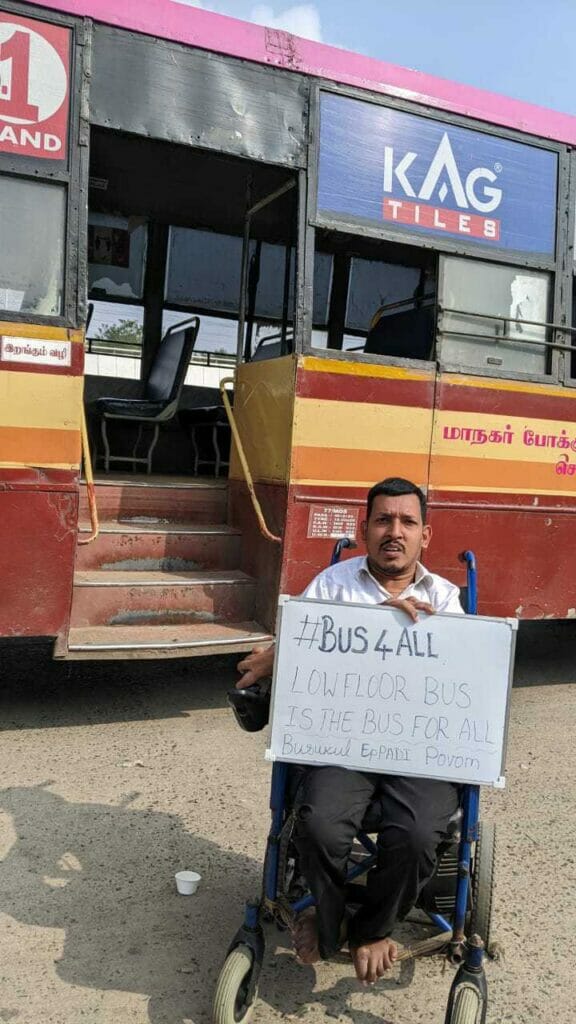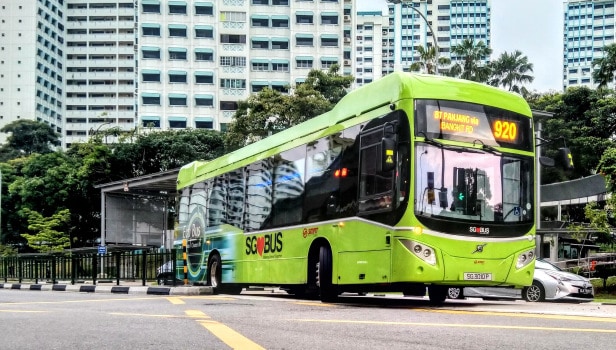Accessible public transport has been a long-pending demand from disability activists across the country. Our repeated efforts have resulted in some progress but there’s still a long way to go for affordable public transport to be inclusive. In the case of Chennai, the long struggle to ensure the procurement of low-floor, accessible buses has been an issue that has reflected the treatment of those with disabilities in the public sphere.
Experience with inaccessible buses in Chennai
My own experience attempting to use buses in Chennai as a person with disabilities has been harrowing.
I had a fall out of a moving bus in November of 2004 as I was struggling to hold on to the grab bar during a turning that the bus took on the road. I was travelling with my mother, who also fell off the bus along with me when she tried to prevent my fall.
The inaccessibility of the bus resulted in injuries that would affect the two of us for life. We also had to deal with insensitivity on part of the driver, conductor and the co-passengers, making this an all too bitter experience to recollect. We can only be thankful that road traffic didn’t run over us additionally.
Fifteen years later, I as a wheelchair user had a bad fall when attempting to board an MTC bus with a lift at a demo organised at the Disability Commissionerate – my wheelchair tipped backwards and my head hit the ground with such force that it necessitated an MRI. I shudder to think of what may have happened on a busy road.
My mother, who was a regular bus user earlier unhampered by mobility issues like mine, can now as a senior citizen no longer manage the steep steps of the trucks that pass as buses in Chennai. She is now experiencing the same needless restrictions in freedom of movement that I and my disability community face.
Accessibility not only helps those with disabilities to approach or use a product or system easily but also ensures the safety and security of persons using the same. This is absolutely nil in 95% of the local bus in Tamilnadu.
As a direct consequence, disabled individuals find themselves unable to commute freely and access opportunities or activities of their choosing. Those who end up commuting do so by paying hefty sums for private transport as public transport facilities remain out of reach.
Read more: Can Universal Design be the magic bullet for an accessible Chennai?
Legal challenge to provide accessible buses in Chennai and Tamil Nadu
A writ petition seeking to make the Metropolitan Transport Corporation (MTC) and the Tamil Nadu State Transport Corporation (TNSTC) buses accessible for all has been through various stages of the legal system in the Madras High Court for the past 17 years.
Despite years of hearings the Transport department has failed to follow the law of the land, the Rights of Persons with Disabilities Act 2016, and the Rights of Persons with Disabilities Rules 2017 which clearly mentions that all services in the country should be made accessible for all persons with disabilities within 2 years from the passage of the Act.
Judgements towards accessible buses were not implemented by the Transport department all these years, despite pointing to accessibility standards of all public transport of which low-floor buses are non-negotiable.
Some of the solutions on offer have been less than desirable. The state government came up with an alternative model for an accessible bus. This was an extremely high-floor bus with an extra step but with a hydraulic lift to help wheelchair users. It’s common sense that an accessible bus should be easy to use for all people and not just wheelchair users. Senior citizens and people with various kinds of pain and dislocation are the majority among the ordinary middle and low-income groups that use public transport on a day-to-day basis. This solution proved unviable for a large section of those seeking to make public transport, especially buses, more inclusive and accessible.
The Transport department, despite forming many committees for sorting out this issue, has been repeatedly submitting that the roads are full of speed-breakers and bumps and are not equipped for low-floor buses. They have also argued that the procurement costs are really high for a low-floor bus and the conversion of entire fleets to low-floor is a process that could take many years if at all.
Why should disabled citizens be penalised for the government’s failure to provide suitable infrastructure for decades?
Read more: Why persons with disability are unhappy with Chennai Metro
Path for accessible buses in Chennai
The deadline for retrofitting earlier built infrastructure (so that disabled citizens could finally freely move in a fully accessible India – a whole 75 years after Independence) was 14 June 2022. On this day, members of the Disability Rights Alliance Tamil Nadu went on a tour of Chennai to see if any steps to improve accessibility had been implemented and found that neither public places nor public transport systems were fully anywhere close to accessible for persons with disabilities. Even when gender safety protocols were introduced in MTC buses recently, women with disabilities were neither encouraged to be heard nor were the installed systems accessible and usable for women with disabilities.
I raised the issue of long-pending accessibility in all buses with the honourable Chief Minister at the State Advisory Board for Persons with Disabilities held in November 2022. Yet, recent submission by the department in the Madras High Court has revealed that only 442 low-entry buses are expected to hit the streets.
Suffices to say that 17 years after my colleague Rajiv Rajan filed his PIL, instead of the entire state running buses for all if court-prescribed orders of accessible bus procurement were complied with, only 2.1% of Tamil Nadu’s 20000+ fleet will be accessible by wheelchair users. Adding thoughtlessness to this ridiculous state of affairs is that these 442 buses will ply only in Chennai, Coimbatore and Madurai.
Are disabled people from elsewhere in Tamil Nadu expected to migrate to these cities in the hope that their stars will align, and they will magically chance upon the rare appearance of a low-floor bus on the limited routes they will presumably run on?
Ignoring law, court, bus body code and conscience, the Tamil Nadu government seems to be patting itself on the back for this laughable 2% in the future – the August 442 low-entry bus tender is surprisingly still open 5 months later – while determined to procure an additional 1771 high floor buses and building an additional 1000 on existing refurbished truck/high-floor bus chassis.
Making this current contested planned procurement of 2771 buses accessible to disabled citizens would increase the proportion of wheelchair-boardable buses to 16%. Still a far cry from Singapore’s effective example of transition – when it shifted from high-floor to low-floor buses it was mandated that all routes have at least 1 in 4 buses as low floor and then progressively increase the realisation of the 100% accessible bus mandate.
Many reasons have been put forth for not taking steps towards making buses and other public transport inclusive and accessible, but the state must bear the blame for the curtailed freedom of movement of persons with disabilities for many decades.
Who will bear the burden of spending much fold on private transport which can be much easy on our pockets if the public transport system is accessible? Will a politician or administrator or authority understand the need for accessibility of all only if they have a member with reduced mobility in their family?
Each year, as the country celebrates Independence Day, the question that dominates our minds is where is our independence, when most of our fellow people with disabilities remain under house arrest due to inaccessible systems and unaffordable transport services?

